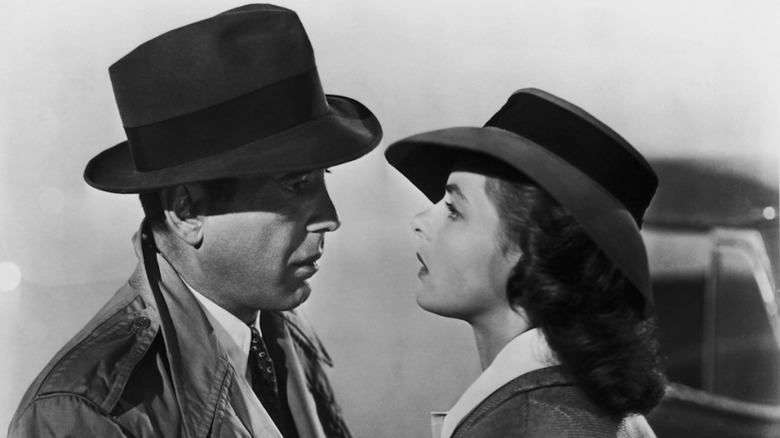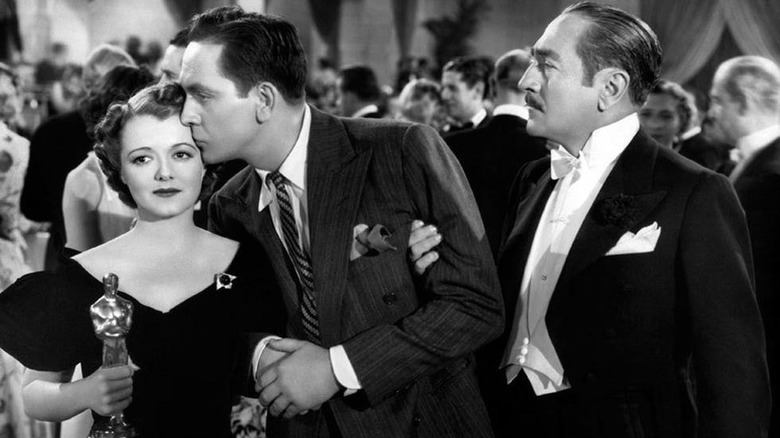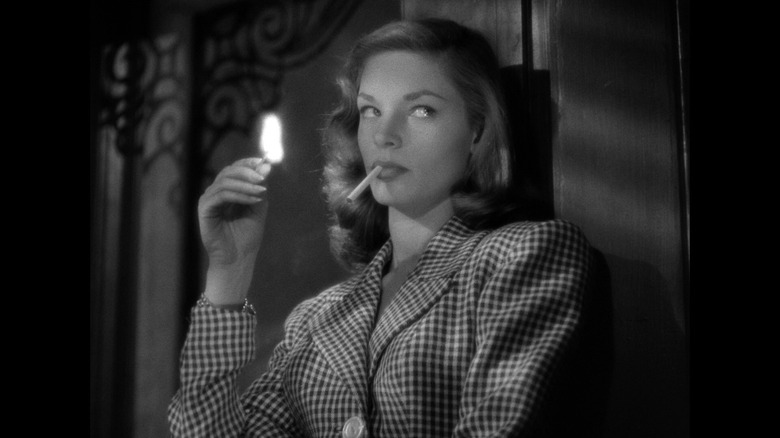One Film Never Failed To Bring Humphrey Bogart To Tears
In the golden age of Hollywood, Humphrey Bogart epitomized the tough guy of the silver screen. He portrayed men who were uniquely American, yet rarely would be considered good role models for young patriots. Bogart was able to maintain the grizzled appearance of a cowboy even when smoking in an alabaster suit. On- and off-screen, a glass of whiskey protruded from his hand like an extra appendage. It's why audiences conflate Bogie with his most iconic role, Rick Blaine from "Casablanca." Under their cynical shells, they were both rank sentimentalists. Once in a while, Bogart's hardened exterior would crumble into tears, as it did during an annual screening of one of his favorite films.
In his book-length tribute to the star, "Bogie: A Celebration of the Life and Films of Humphrey Bogart," Richard Schickel paints a scene that illustrates Bogart's softer side. Each Christmas Eve, Bogart would invite friends over to drink and watch William A. Wellman's 1937 film "A Star is Born." The Hollywood tragedy about an ingénue's rise to fame as her husband falls from grace is one so timeless that it has been remade three times (most recently in the Oscar-winning 2018 film starring Bradley Cooper and Lady Gaga), and Wellman's film is itself actually a loose remake of George Cukor's 1932 melodrama "What Price Hollywood?"
Each iteration of "A Star is Born" tells the same story: a young, unconventionally beautiful talent falls in love with an alcoholic celebrity who eventually commits suicide. Something in that premise touched the famously stoic Bogart deeper than most other films.
The battling Bogarts
Schickel writes that guests at the annual screening would find the headstrong Bogart weeping by the end of the film:
"One has to think that in contemplating the sad fate of Norman Maine, the movie star who succumbs to alcoholism and suicide in that film, Bogart may have been contemplating his own good fortune in narrowly escaping a similarly miserable end. For certain there were parallels in their stories that went far beyond their addiction to booze: The air they projected of being finer than their surroundings, their contempt for Hollywood manners and morals, their redemptive love for a young woman star in whose discovery they participated."
As Schickel notes, there were parallels between Bogart's life and the life of the fictional Maine. Bogart's alcoholic exploits were infamous in Hollywood. He started fights everywhere he went, even with casino parking lot attendants. Those incidents were comedic at times, as when Bogart and a friend brought two stuffed pandas as "dates" to the El Morocco nightclub in Manhattan. When a woman approached him, a drunken Bogart pushed her away and said, "Get away from me! I'm a happily married man. And don't touch my panda!"
More often Bogart's alcoholism would turn ugly. He and his third wife, Mayo Methot, would drink to excess and their violent fighting branded the couple as "the Battling Bogarts" (via Vanity Fair). The 43-year-old actor was still married to Methot when he met 19-year-old Lauren Bacall on the set of their first film together, "To Have And Have Not." Their electric screen chemistry grew out of an on-set affair, leading Bogart to divorce Methot and marry Bacall in 1945.
Bogie and Bacall
Like his wry, romantic characters, Bogart let his tough facade slip away to reveal his mushy emotions from time to time. He was known to shed a tear on occasion, particularly at his four weddings. In her autobiography, "By Myself," Lauren Bacall recalled Bogart's nuptial tears at their wedding (via The Week):
"Throughout their courtship, Bacall describes Bogart as shy, gentle, vulnerable, and open, confiding in her about his three failed marriages. During their small wedding in Ohio, 'tears streamed down [Bogart's] face.' According to Bacall, this outburst of emotion was Bogart's reaction to hearing the words of the wedding ceremony and finally 'realizing what they meant — what they should mean.'"
For all the masculine bravado that he projected in his films, Bogart was a man haunted by self-doubt. Bacall represented the woman of his dreams: She was a feisty and strong dame who could meet him at his level. They became each other's great love and comfort. The tears he shed at their wedding and at his yearly screenings of "A Star is Born" may have reflected the relief he felt in finally finding someone with whom he could let his guard down, steering clear of Maine's tragic end.


